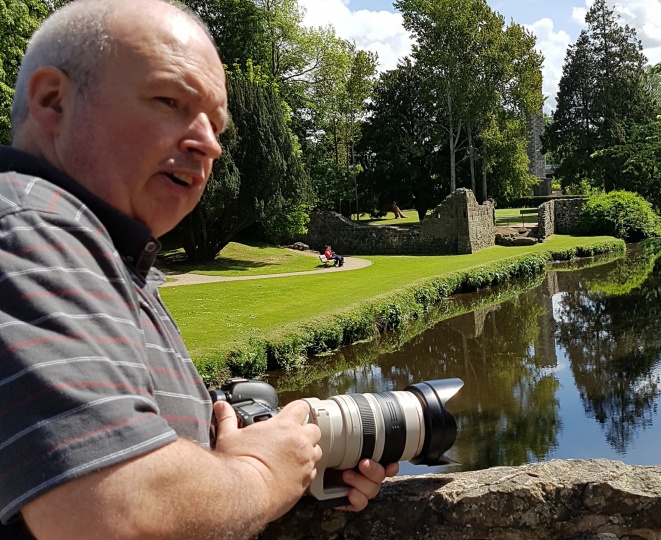Remembering Seamus Kelters: Pioneering Trauma Journalist
Seamus Kelters, Crumlin Glen, Northern Ireland, May 2017.
Seamus Kelters was a reporter, a local journalist covering his home turf for his entire career. He was a lot like other first-rate local reporters: that well-attuned eye for the absurd and the hypocritical; that stubborn sense of justice; and that intimate knowledge of people, places and enough backstories to end careers and marriages if he not been such a generous soul. But Seamus’ hometown was Belfast. When Seamus was nine his family and neighbors evacuated from their homes in one of Belfast’s few mixed Catholic-Protestant developments, because British soldiers and contending paramilitaries turned it into a free-fire zone. In his first days as a newly-hired reporter at the Irish News he was covered an IRA funeral in Milltown Cemetery when a loyalist hitman rained bullets and grenades down on the mourners. Being a local reporter meant scooping the competition in an exclusive interview with the newly-freed Birmingham Six (portrayed onscreen in “In The Name Of The Father”), beating the competition just because he’d treated those families decently throughout their years-long courtroom ordeal. It meant carefully calibrating words at press conferences during the most anguished, nerve-wracking days of the Good Friday peace negotiations, when even a needlessly provocative question from a reporter might send the whole thing off the rails.
I first met Seamus in 2002 in one of the first Dart Center Ochberg Fellowships. He was wary; he had come reluctantly, at the behest of his bosses at BBC Belfast, and figured he was in for a week of soft-headed do-gooderism. A day or so in, a lightbulb switched on; he embraced the idea of reporters learning about trauma from the best minds in psychology and psychiatry, and applying that knowledge to our own work. From that moment on there was no stopping him.
Seamus introduced me to the remarkable generation of Northern Irish journalists who chronicled brutal civil conflict afflicting their own community. We brought many of those reporters and editors together over a weekend in 2004 that I still contemplate and draw upon. People wander into journalism from all kinds of backgrounds and for all kinds of reasons. In the crucible of the Troubles, Seamus had decided that reporting with depth and integrity was the best response to sectarian violence. For him, and many of his colleagues, journalism was not only a profession but the alternative to picking up a gun. Seamus was an Irish Republican who worked side by side with unionist and loyalist colleagues covering marches and massacres, peace negotiations and parliamentary stalemates. He often told me that he and his best friends in the newsroom trusted one another with their lives yet never discussed how they voted. He was constantly alive to contradictions and inner conflicts; I remember him saying about the Omagh bombing, the single most deadly attack of the Troubles, that while reporting at the ghastly scene he wanted to be nowhere but home with his wife Camilla and his sons Brendan and Michael - but that once home, he was equally desperate to get back to covering the story.
Seamus liked to tell long, funny yarns and I guess they were mostly true. He was a ruthless pool shark - I watched him pummel all comers in a Chicago neighborhood bar, with an intimidating ferocity of gaze over the cue that I think he learned from staring down cops and Provos. He loved photography and all the secret crafts of television and radio production - he could work himself into hilarious outrage over someone’s badly edited tape.
Seamus’ monumental contribution was Lost Lives, 1 million words compiled with David McKittrick, Chris Thornton and Brian Feeney which will be studied 100 years from now by people trying to understand how civil conflict spins out of control. Among other things Lost Lives is a masterwork of investigative journalism, based on a database Seamus began compiling long before “data journalism” was a buzzword. Seamus didn’t talk much about all the labor involving in researching and tracking 3,700+ killings, but he talked a lot about the passionate, granular arguments he and his co-authors had in trying to ensure the accuracy and even-handed treatment of each and every case.
Today Northern Ireland is more famous as the set for the fantasy battles of Game of Thrones than the setting of real-life bloodletting. Thanks to the Good Friday peace process – still unfinished and newly stressed by Brexit - Seamus was able to turn his investigative talents in recent years to officials’ funny-money deals, to animal abuse and environmental crime and other targets. Young reporters in Belfast now work among smart glass-fronted office towers unimaginable in the bad days of bombs and bullets. But the standard Seamus and his colleagues established in the worst years of the Troubles still sets Northern Irish journalism apart. We shall not see his like again.
- Previous Section
Gavin Rees: Those Bullets Never Stop Traveling

































































































